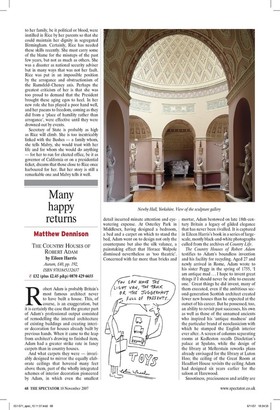Many happy returns
Matthew Dennison THE COUNTRY HOUSES OF ROBERT ADAM by Eileen Harris Attrum, £40, pp. 192, ISBN 9781845132637 © £32 (plus £2.45 p&p) 0870 429 6655 Robert Adam is probably Britain's most famous architect never to have built a house. This, of course, is an exaggeration, but it is certainly the case that the greater part of Adam's professional output consisted of remodelling the internal architecture of existing buildings and creating interior decoration for houses already built by previous hands. When it came to the leap from architect's drawing to finished item, Adam had a greater strike rate in fancy carpets than in country houses.
And what carpets they were — invariably designed to mirror the equally elaborate ceilings that hovered many feet above them, part of the wholly integrated schemes of interior decoration pioneered by Adam, in which even the smallest detail incurred minute attention and eyewatering expense. At Osterley Park in Middlesex, having designed a bedroom, a bed and a carpet on which to stand the bed, Adam went on to design not only the counterpane but also the silk valance, a painstaking effect that Horace Walpole dismissed nevertheless as 'too theatric'. Concerned with far more than bricks and mortar, Adam bestowed on late 18th-century Britain a legacy of gilded elegance that has never been rivalled. It is captured in Eileen Harris's book in a series of largescale, mostly black-and-white photographs culled from the archives of Country Life.
The Country Houses of Robert Adam testifies to Adam's boundless invention and his facility for recycling. Aged 27 and newly arrived in Rome, Adam wrote to his sister Peggy in the spring of 1755, 'I am antique mad ... I hope to invent great things if I should never be able to execute one.' Great things he did invent, many of them executed, even if the ambitious second-generation Scottish architect created fewer new houses than he expected at the outset of his career. But he possessed, too, an ability to revisit past successes, his own as well as those of the unnamed ancients who inspired his 'antique madness' and the particular brand of neoclassicism with which he stamped the English interior ever after. A screen of columns separating rooms at Kedleston recalls Diocletian's palace at Spalato, while the design of the library at Mellerstain reworks plans already envisaged for the library at Luton Hoo; the ceiling of the Great Room at Headfort House revisits the ceiling Adam had designed six years earlier for the saloon at Harewood.
Snootiness, preciousness and aridity are the pitfalls of much writing on architectural history. Eileen Harris writes with complete authority, in a style that is pithy and, intermittently, refreshingly astringent. Honorary librarian and consultant to the Adam Project at the Sir John Soane Museum, a repository of many of Adam's original watercolour designs, she is unsparing towards those whose custodianship of Adam's legacy she finds wanting. Of the 1978 repainting of the Tapestry Room ceiling at Newby Hall in a mushroom-based palette remote from Adam's original intention, she records tartly, 'As a result, the geometrical pattern of the ceiling and the inset paintings are too prominent, likewise the green and gold carpet with red and brown ornaments designed by Adam in 1775. The finely tuned balance orchestrated by Adam is spoilt.' Other disappointing restorations are dismissed as appropriately dull for buildings which have fallen into commercial use.
This is a handsome and impressive book. The survival of so few of Adam's schemes in their original colouring makes the case for Counny Life's eloquent blackand-white photographs. Harris's focus throughout is Adam's work: she does not concern herself with social history, with the result that, despite its potentially nostalgic appearance, her survey is consistently briskly informative.






































































 Previous page
Previous page